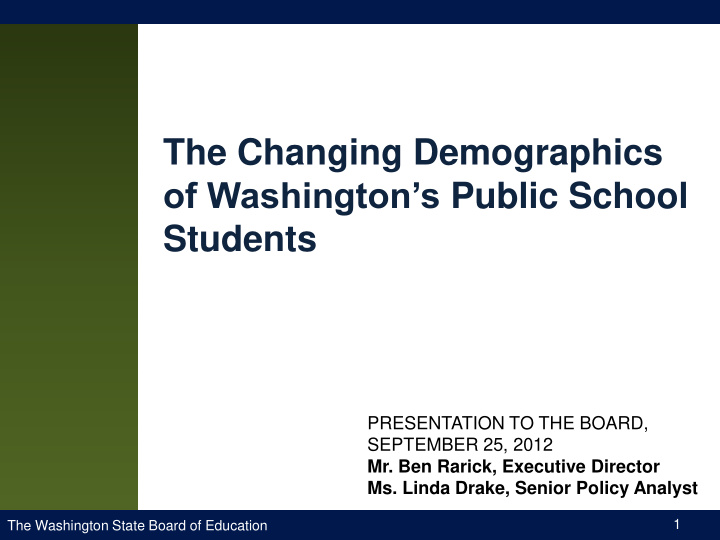



The Changing Demographics of Washington’s Public School Students PRESENTATION TO THE BOARD, SEPTEMBER 25, 2012 Mr. Ben Rarick, Executive Director Ms. Linda Drake, Senior Policy Analyst 1 The Washington State Board of Education
Forecast of School Age Population, Age 5 to 17 Forecast 1,550,000 1,450,000 The “Third Wave” of the 1,350,000 baby boom starts in 2013 School Age Population 1,250,000 By 2025, about 1,265,100 1,150,000 1,050,000 950,000 Currently, 1,135,282 850,000 750,000 1980 1990 2000 2010 2020 2030 2040 Year Forecast of the State Population, November 2011 Forecast, Forecasting Division, State of Washington Office of Financial Management 2 The Washington State Board of Education
School Age Population, Race and Ethnicity Projections of the Percent of School Age (5-19) Population by Race and Ethnicity 100% 90% 80% 70% 60% Percent 50% 40% 30% 20% 10% 0% 2000 2005 2010 2015 2020 2025 2030 Year Hispanic 2 or more Asian/Pacific Islander American Indian/Alaska Native Black White WA Office of Financial Management November 2011 Forecast of state population by age and sex 2010-2040 3 The Washington State Board of Education
Where are the students going to be? Projected Percent Change of School Age Population (ages 5-19) 2010-2025 OFM May 2012 Forecast 4 The Washington State Board of Education
If the trend Percent of children in poverty in Washington continues, State 1997 to 2010 the percent of children 20 in poverty in 18 2020 will be 16 about 18.8% 14 12 Poverty Percent 10 guidelines Linear (Series1) 8 for or a y = 0.2387x - 463.37 family of 4: 6 $23,050 4 2 0 1996 1998 2000 2002 2004 2006 2008 2010 Year The percent of children under age 18 who live in families with income below the poverty threshold (100% Federal Poverty Guidelines). US Census Bureau’s Small Area Income and Poverty Estimates. 5 The Washington State Board of Education
Children in Poverty in Washington State 2010 Okanogen Stevens Grays Harbor Grant Adams * * * Franklin Yakima Cowlitz Walla Walla * Counties with highest percent change in student population 6 The Washington State Board of Education
ELL English Language Learners (ELL) Headcount, October 2010: 92,084, 8.8% of Total Enrollment OSPI Report to the Legislature, Educating English Language Learners in Washington State 2010-11, December 2011 • ELL enrollment has increased by 15.4% since 2005-2006 • 208 primary, non-English languages were represented in the Transition Bilingual Instruction Program, with Spanish accounting for 67% of ELLs 7 The Washington State Board of Education
Percent Change of Linguistically Isolated Households*: 1990-2000 Figure by Kirschner , A, for “Work Force Issues for Governing Boards” presented by Menaul, R, Garcia, J, and Phippen, E., the Health Work Force Institute and the Washington State Hospital Association, May 20, 2009. 8 The Washington State Board of Education
Special Special Education Students, Age 6-21 Education, age 6-21, 140000 2010: 113,758, 120000 11.0% of 14. Traumatic Brain Injury Total 13. Autism Enrollment 100000 12. Communication Disorders (stayed within 11. Deaf-Blindness 1 percentage 10. Visual Impairments 80000 point for past 9. Hearing Impairments 8. Deafness 8 years) 7. Multiple Disabilities 60000 6. Intellectual Disability 5. Specific Learning Disabilities 4. Health Impairments 40000 3. Orthopedic Impairments 2. Emotional/Behavioral Disability 1. Developmental Delays 20000 OSPI Special Education 0 Child County and Placement 2004 2005 2006 2007 2008 2009 2010 2011 Data, Federal LRE and Child County Data 9 The Washington State Board of Education
School Age Population Compared to +65 Population OFM May 2012 Forecast Age Distribution Age Distribution 2010 Projected for 2020 +65 Population Outnumbers School Age Population +65 Population and School Age Population Approximately Balanced School Age Population Significantly Outnumbers +65 Population • Districts with higher proportion of seniors will be challenged to keep the community engaged in education • Support for public school funding is likely to be lower Figlio, D. and D. Fletcher (2010). Suburbanization, Demographic Change and the Consequences for School Finance 10 The Washington State Board of Education
Summary of Data Steadily growing statewide enrollment • Uneven growth around the state • High poverty in some high growth areas An increasingly diverse student population • Increasing percent of ethnic and racial student groups • Increasing percent of ELLs • Increasing number of Special Education Students Many communities will have a larger senior- age population than school-age population 11 The Washington State Board of Education
Opportunities and Challenges How should our schools change to meet the changing needs of our students? How do we make the most of what our students have to offer? 12 The Washington State Board of Education
Recommend
More recommend